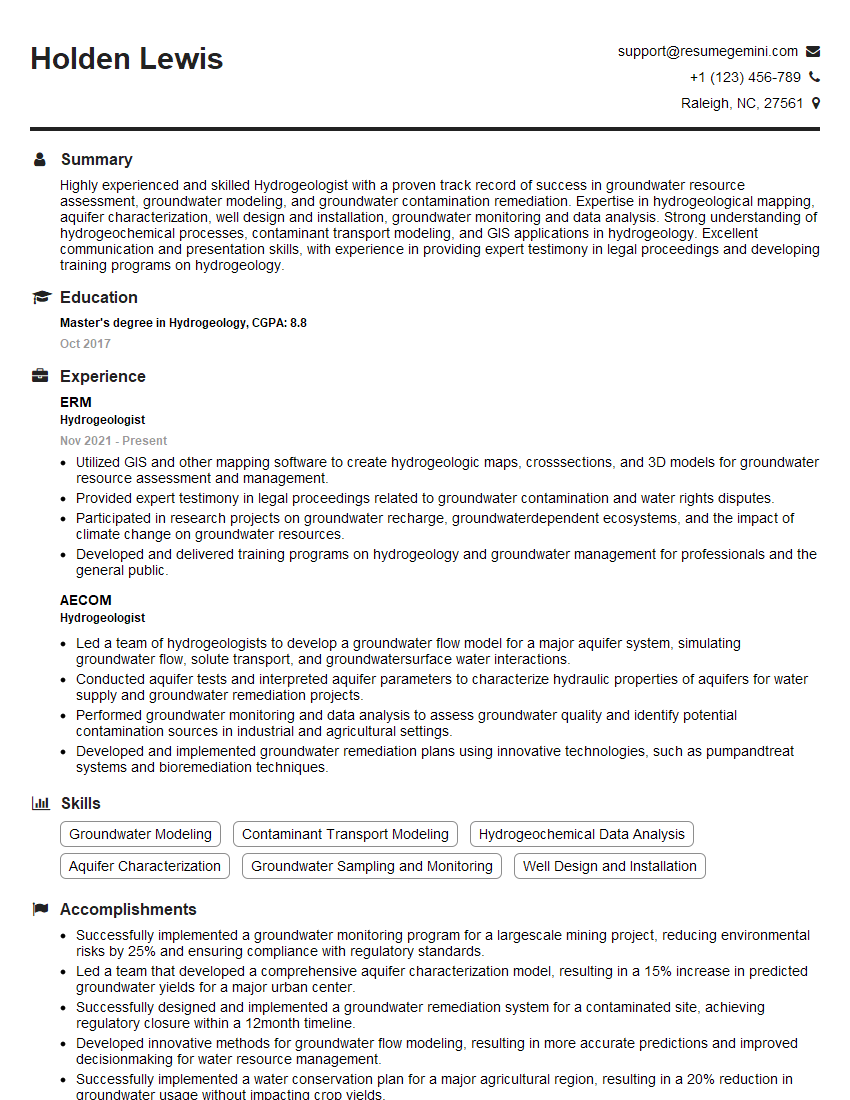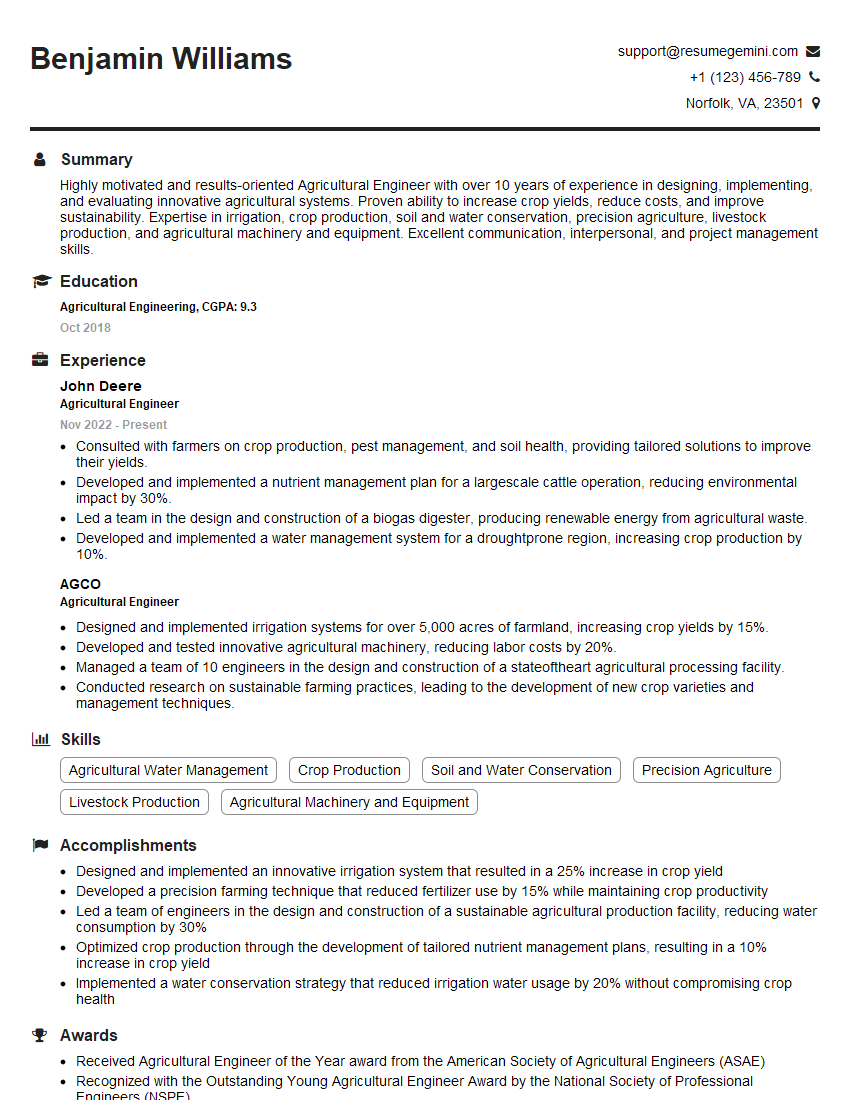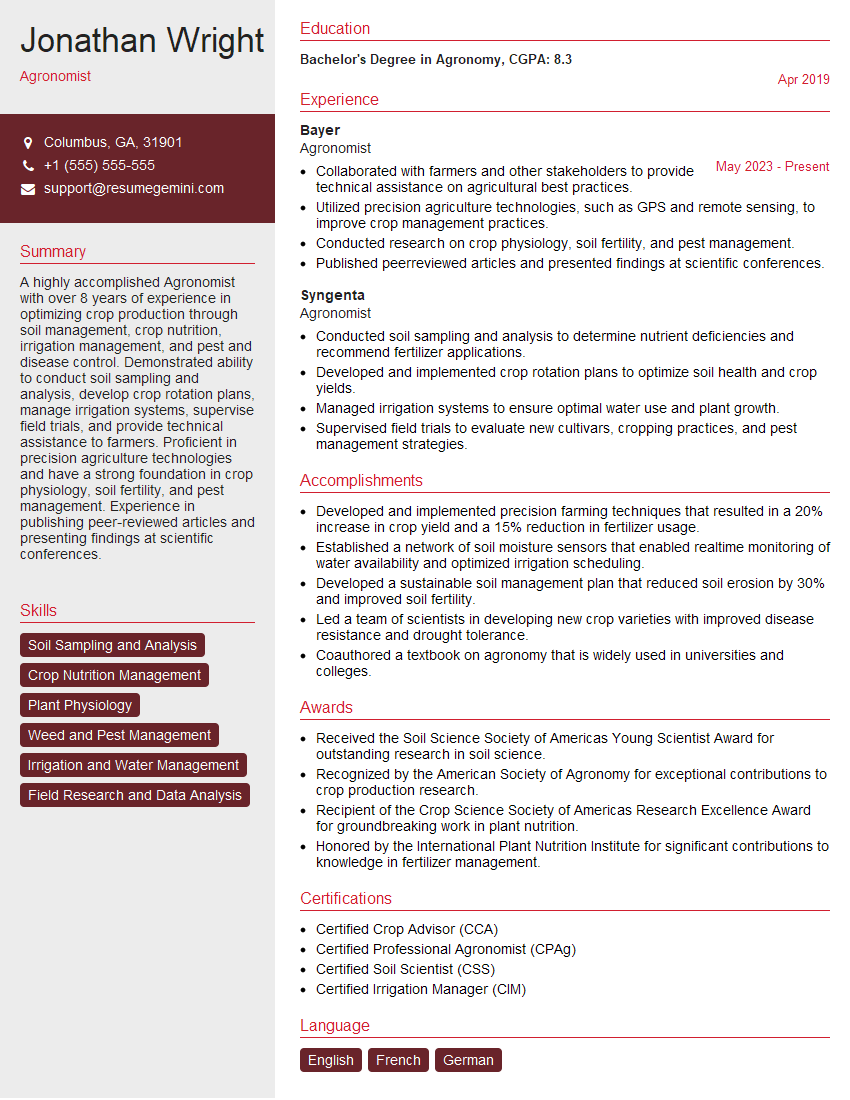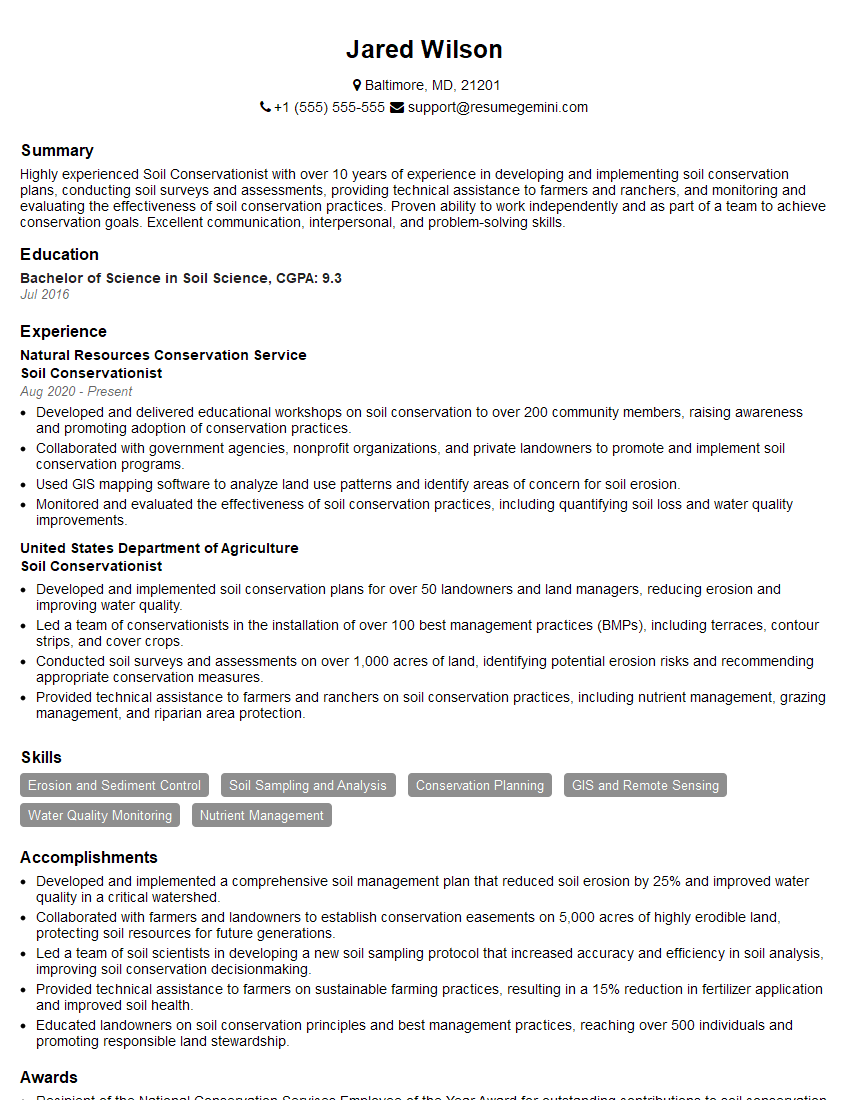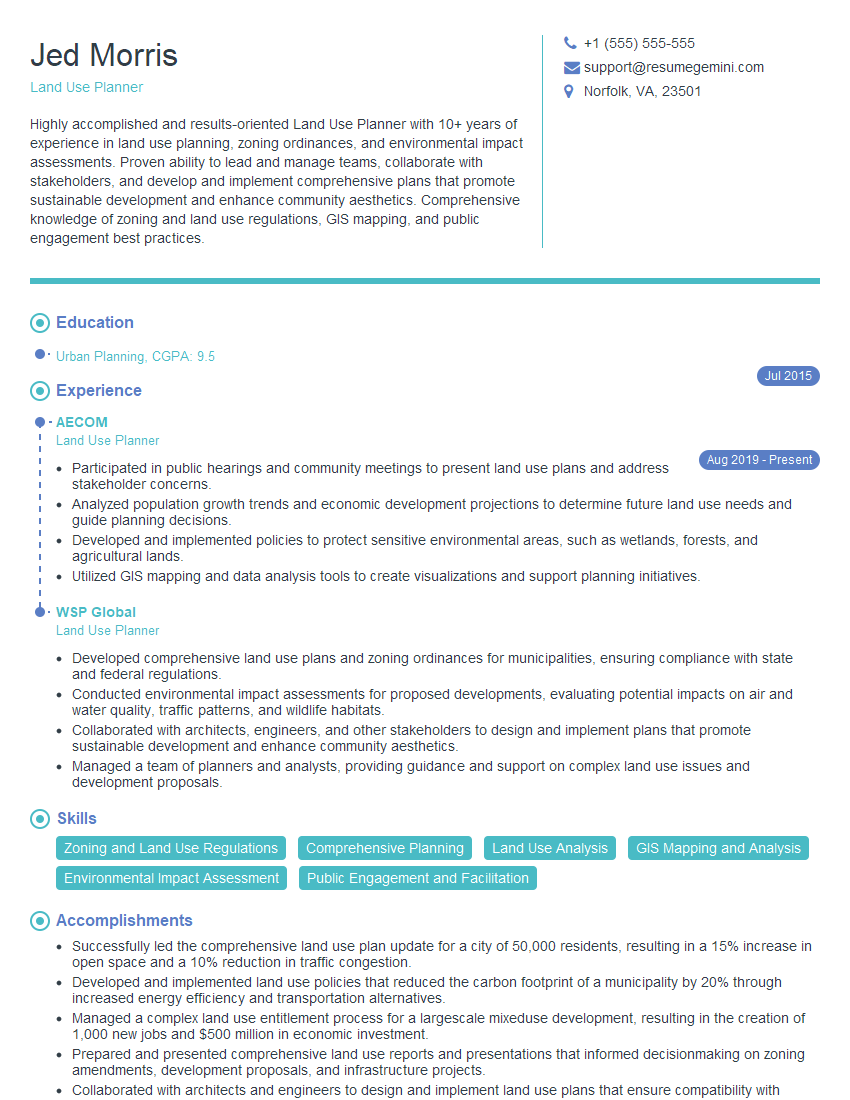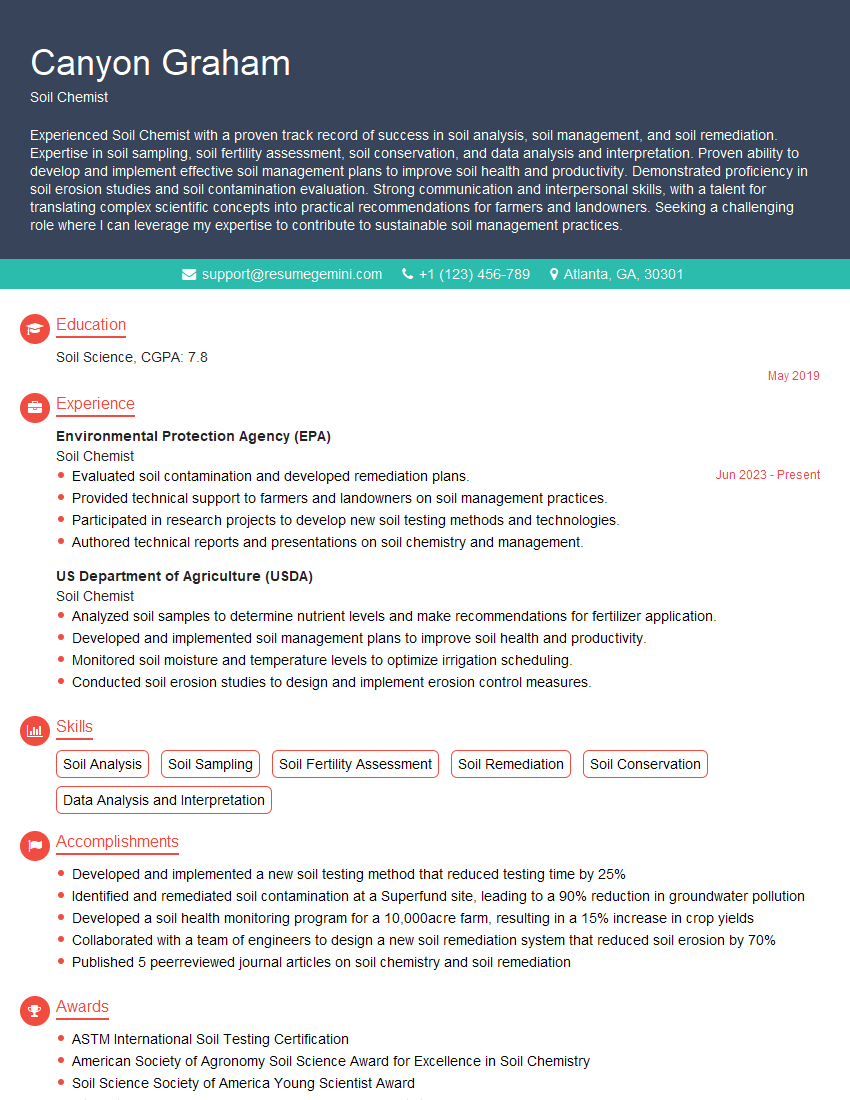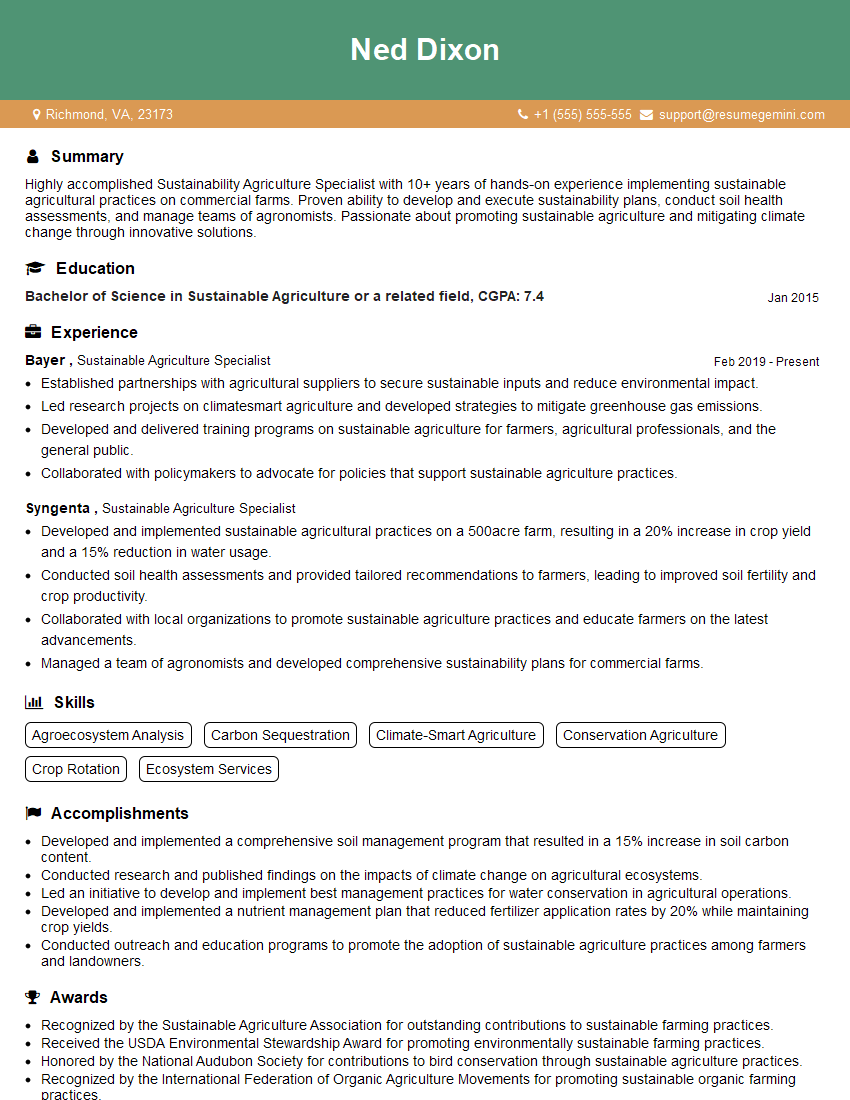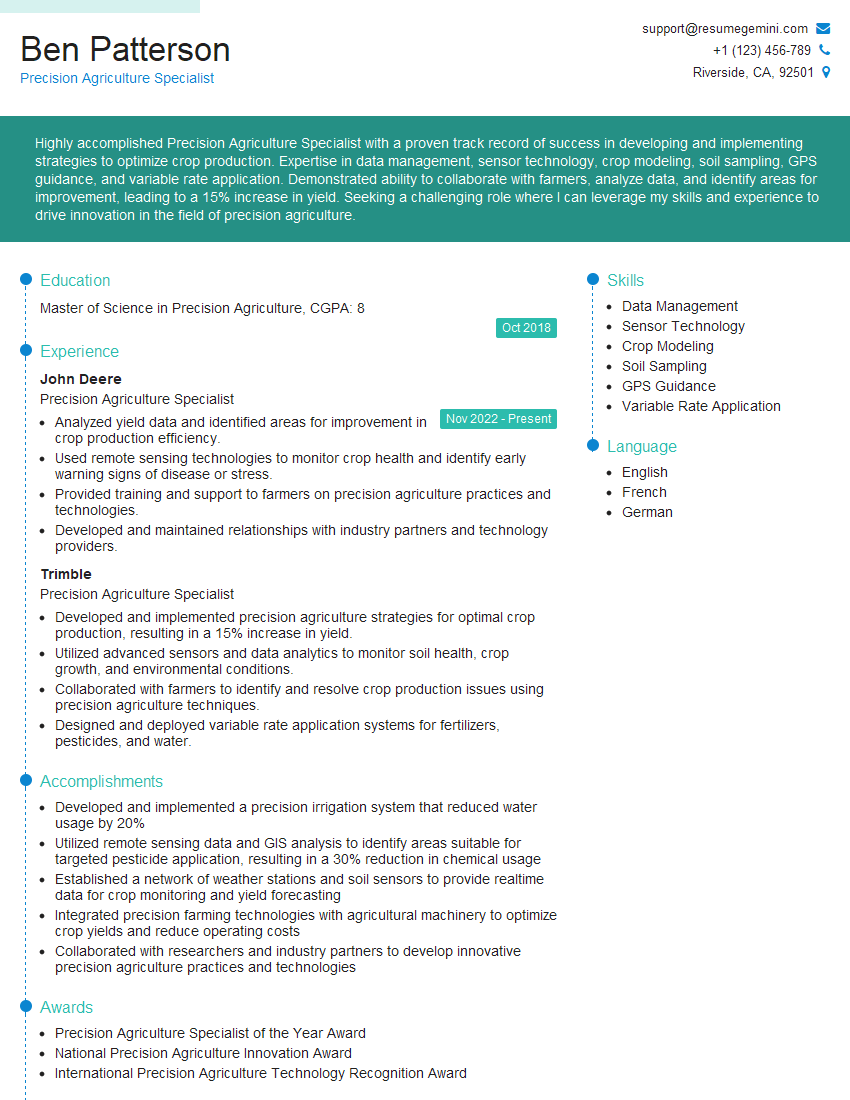Every successful interview starts with knowing what to expect. In this blog, we’ll take you through the top Soil Health and Management interview questions, breaking them down with expert tips to help you deliver impactful answers. Step into your next interview fully prepared and ready to succeed.
Questions Asked in Soil Health and Management Interview
Q 1. Explain the concept of soil health and its importance in agriculture.
Soil health refers to the capacity of soil to function as a vital living ecosystem that sustains biological activity, promotes plant growth, and supports water and nutrient cycling. It’s not just about the absence of disease or pests, but about the overall thriving of the soil’s biological community.
In agriculture, healthy soil is paramount. It directly impacts crop yields, reduces reliance on synthetic inputs like fertilizers and pesticides, enhances water use efficiency, and improves resilience to climate change impacts like droughts and floods. Think of it like this: a healthy soil is like a healthy human body – it can better resist diseases and perform optimally. Unhealthy soil, on the other hand, is less productive and more susceptible to damage.
For example, a farm with healthy soil might require less irrigation because the soil structure holds water more effectively, leading to cost savings and environmental benefits.
Q 2. Describe the different soil textures and their impact on water retention and aeration.
Soil texture refers to the relative proportions of sand, silt, and clay particles that make up a soil. These particles differ significantly in size and this influences many soil properties.
- Sand: Large particles, good aeration (lots of space between particles), poor water retention (water drains quickly).
- Silt: Medium-sized particles, moderate aeration and water retention.
- Clay: Small particles, poor aeration (particles are tightly packed), excellent water retention (water is held tightly).
The impact on water retention and aeration is significant. Sandy soils drain rapidly, leading to frequent irrigation needs and potential nutrient leaching. Clay soils retain water well but can become waterlogged, hindering root aeration and plant growth. Loam soils, which are a balanced mixture of sand, silt, and clay, generally offer the best combination of aeration and water retention, making them ideal for many crops.
Imagine a sponge: a sandy soil is like a coarse sponge that drains quickly, a clay soil is like a very dense sponge that holds water but doesn’t allow air to pass easily, and a loam soil is like a well-structured sponge with the right balance of porosity and water-holding capacity.
Q 3. What are the key indicators of soil health?
Key indicators of soil health encompass several factors, offering a holistic view of soil functionality. These include:
- Soil Organic Matter (SOM): High SOM content indicates thriving soil biology and improved water retention, nutrient cycling, and overall soil structure.
- Soil Structure: A well-aggregated soil, with visible clumps or aggregates, indicates good aeration and water infiltration. Poor structure often shows as compacted, dense soil.
- Biological Activity: Assessed through measurements of earthworm populations, microbial biomass, and enzyme activity. A diverse and abundant soil biota is a sign of a healthy ecosystem.
- Nutrient Levels: Sufficient levels of essential nutrients (nitrogen, phosphorus, potassium, etc.) are crucial for plant growth. Deficiencies can limit yields.
- Water Holding Capacity: The soil’s ability to retain water is crucial for plant survival, particularly during dry periods.
- pH: Soil pH influences nutrient availability. Optimal pH ranges vary depending on the crop and specific nutrients.
Monitoring these indicators over time helps track the soil’s health and inform management decisions.
Q 4. How do you assess soil nutrient levels and deficiencies?
Soil nutrient levels and deficiencies are assessed using a combination of methods:
- Soil Testing: A laboratory analysis of a soil sample provides quantitative data on the concentrations of various nutrients. This is the most common and reliable method.
- Plant Tissue Analysis: Analyzing the nutrient content of plant tissues (leaves, stems) can reveal nutrient deficiencies even if soil tests show adequate levels. This is because nutrient uptake can be influenced by many factors besides soil nutrient content.
- Visual Symptoms: Experienced agronomists can often identify nutrient deficiencies based on visual symptoms exhibited by plants (e.g., chlorosis, necrosis). This is a less precise but helpful initial assessment.
Soil testing usually involves collecting representative soil samples according to a specific sampling plan and sending them to a laboratory for analysis. The results will indicate the levels of different nutrients, enabling farmers to make informed decisions regarding fertilizer application.
Q 5. Explain the role of soil organic matter in soil health.
Soil organic matter (SOM) is the lifeblood of healthy soil. It’s composed of decomposed plant and animal residues, microbial biomass, and other organic compounds. SOM plays a multitude of vital roles:
- Improved Soil Structure: SOM acts as a binding agent, enhancing aggregation and preventing compaction. This leads to better water infiltration, aeration, and root growth.
- Enhanced Water Retention: SOM increases the soil’s water holding capacity, reducing irrigation needs and improving drought resilience.
- Nutrient Cycling: SOM acts as a reservoir for essential nutrients, slowly releasing them for plant uptake. This reduces the reliance on synthetic fertilizers.
- Increased Biological Activity: SOM provides a food source for soil organisms, supporting a diverse and abundant soil biota.
- Carbon Sequestration: SOM stores carbon, helping mitigate climate change.
Think of SOM as the ‘glue’ that holds the soil together, provides food for the soil’s living organisms, and regulates the release of nutrients. Increasing SOM is a cornerstone of sustainable soil management.
Q 6. Describe various soil erosion control methods.
Soil erosion control methods aim to minimize the detachment and transport of soil particles by water or wind. Methods can be broadly categorized into:
- Mechanical Methods: These involve physical structures to control erosion. Examples include contour farming (plowing along the contours of the land), terracing (creating level platforms on slopes), and windbreaks (planting trees or shrubs to reduce wind speed).
- Vegetative Methods: These use plants to protect the soil. Cover cropping (planting crops specifically to protect the soil), no-till farming (minimizing soil disturbance), and intercropping (planting different crops together) are examples.
- Chemical Methods: These use chemical agents to improve soil stability. Soil conditioners can bind soil particles and improve aggregation. This approach is often less sustainable than others.
- Management Practices: These involve changes in farming practices to minimize erosion. Crop rotation, reduced tillage, and appropriate grazing management are examples.
The best approach often involves a combination of these methods, tailored to the specific soil type, climate, and land use.
Q 7. Discuss different soil sampling techniques and their applications.
Soil sampling techniques are crucial for accurate assessment of soil properties. The methods employed depend on the purpose of the sampling and the scale of the assessment.
- Composite Sampling: Multiple samples are collected from a field area and combined to represent the average soil properties of that area. This approach is cost-effective for large fields but may mask localized variations.
- Grid Sampling: Samples are collected at regular intervals across a field, creating a grid pattern. This method provides more detailed information on spatial variability in soil properties.
- Zone Sampling: Samples are collected from different areas within a field that exhibit distinct characteristics (e.g., slope, soil type). This is useful when significant heterogeneity exists.
- Point Sampling: Individual samples are taken from specific locations to investigate localized issues or assess the impact of particular management practices.
Proper sampling techniques involve using appropriate tools, ensuring representative samples, and meticulously recording sample locations and details. The chosen sampling method dictates the scale and accuracy of the results and subsequently the effectiveness of any subsequent management practices. A poorly collected sample will render any laboratory analysis worthless.
Q 8. How do you interpret soil test results?
Interpreting soil test results is crucial for effective soil management. It’s like getting a health check-up for your land. The results provide a snapshot of your soil’s chemical, physical, and sometimes biological properties. We look at key indicators like:
- pH: Indicates soil acidity or alkalinity. Optimal pH varies depending on the crop, but generally, a slightly acidic to neutral range (6.0-7.0) is ideal for most plants. A pH outside this range can hinder nutrient availability.
- Nutrient Levels (e.g., N, P, K): Shows the concentrations of essential plant nutrients. Low levels indicate the need for fertilization, while excessively high levels might indicate potential environmental concerns.
- Organic Matter: A measure of the soil’s organic content, vital for soil structure, water retention, and nutrient cycling. High organic matter is generally desirable.
- Texture (sand, silt, clay): Determines the soil’s drainage, aeration, and water-holding capacity. The ideal balance depends on the crop and climate.
- Cation Exchange Capacity (CEC): Reflects the soil’s ability to hold and exchange nutrients. Higher CEC generally indicates better nutrient retention.
Once we have these results, we can tailor management practices – like fertilization, liming (to adjust pH), or amendments (to improve organic matter) – to meet the specific needs of the soil and the intended crops. For example, if a test reveals low phosphorus, we might recommend applying a phosphorus-rich fertilizer. If the soil is too acidic, liming can raise the pH to a more suitable range.
Q 9. Explain the principles of sustainable soil management.
Sustainable soil management focuses on maintaining and enhancing soil health over the long term. It’s about treating the soil as a living ecosystem rather than just a medium for plant growth. The core principles include:
- Minimizing Soil Disturbance: Reducing tillage helps protect soil structure, organic matter, and beneficial soil organisms.
- Maximizing Soil Cover: Using cover crops, mulches, or other strategies to keep the soil surface protected from erosion and the sun.
- Diversifying Crop Rotation: Rotating different crops helps maintain soil fertility, reduce pest and disease problems, and improve soil structure.
- Optimizing Nutrient Cycling: Using practices like cover cropping, compost application, and manure management to improve nutrient availability and reduce reliance on synthetic fertilizers.
- Integrating Pest and Disease Management: Employing biological controls, crop rotation, and other sustainable methods to minimize pest and disease pressure, reducing the need for pesticides.
- Improving Water Management: Employing techniques like conservation tillage and water harvesting to enhance water infiltration and retention in the soil.
These principles work together to create a resilient soil system that is more productive, resistant to erosion, and environmentally friendly.
Q 10. What are the impacts of tillage practices on soil health?
Tillage practices, which involve plowing or otherwise disturbing the soil, have significant impacts on soil health, both positive and negative. Historically, tillage was used to control weeds and prepare seedbeds but it often leads to:
- Soil Erosion: Removing crop residue exposes the soil to wind and water erosion, leading to loss of topsoil and nutrients.
- Reduced Organic Matter: Tillage accelerates the decomposition of organic matter, reducing its beneficial effects on soil structure, water holding capacity, and nutrient cycling.
- Compaction: Heavy machinery can compact the soil, reducing aeration and root penetration. This can negatively impact plant growth.
- Loss of Soil Biodiversity: Tillage disrupts soil ecosystems, harming beneficial soil organisms like earthworms and microbes.
However, some minimal tillage methods aim to reduce these negative impacts while still achieving weed control and seedbed preparation. No-till farming, for example, leaves crop residue on the soil surface, protecting it from erosion and improving soil health over time.
Q 11. Describe the benefits of cover cropping.
Cover cropping involves planting a crop specifically to improve soil health, rather than for harvest. It’s like giving your soil a nutritional boost and a protective layer. The benefits are numerous:
- Improved Soil Structure: Cover crop roots help improve soil aggregation (clumping of soil particles), enhancing water infiltration and aeration.
- Increased Organic Matter: Cover crops add organic matter to the soil as they decompose, improving soil fertility and water-holding capacity.
- Reduced Erosion: Cover crops protect the soil surface from wind and water erosion.
- Nutrient Cycling: Some cover crops effectively scavenge nutrients from the soil, preventing nutrient loss and making them available for subsequent crops.
- Weed Suppression: Cover crops can compete with weeds, reducing weed pressure and the need for herbicides.
- Improved Water Infiltration: Cover crops help to improve the soil’s ability to absorb water, reducing runoff and improving water use efficiency.
For example, legumes like clover fix atmospheric nitrogen, enriching the soil with this essential nutrient. Rye can help suppress weeds, and various other cover crops offer different benefits tailored to specific soil and climate conditions.
Q 12. Explain the role of soil microorganisms in nutrient cycling.
Soil microorganisms, including bacteria, fungi, and actinomycetes, are essential players in nutrient cycling. They act as nature’s recyclers, transforming organic matter into forms plants can use. This complex process involves several steps:
- Mineralization: Microbes break down organic matter (dead plants, animals, etc.) into simpler inorganic forms of nutrients like nitrogen, phosphorus, and potassium. This makes these nutrients available for plant uptake.
- Immobilization: Microbes also temporarily absorb nutrients from the soil, making them unavailable to plants. This is a natural part of the cycle.
- Nitrogen Fixation: Certain bacteria, particularly those associated with legume roots, convert atmospheric nitrogen into forms plants can utilize. This is a crucial process, as nitrogen is often a limiting nutrient for plant growth.
- Decomposition: Microbes decompose organic matter, releasing nutrients back into the soil. The rate of decomposition depends on factors like temperature, moisture, and the type of organic matter.
Healthy soil with a diverse microbial community is crucial for efficient nutrient cycling. Practices that enhance soil organic matter, like cover cropping and compost application, promote microbial activity and improve nutrient availability for plants.
Q 13. How does climate change affect soil health?
Climate change poses significant threats to soil health. Increased temperatures, altered precipitation patterns, and more frequent extreme weather events can all have negative consequences:
- Increased Erosion: More intense rainfall events can lead to increased soil erosion, losing valuable topsoil and nutrients.
- Changes in Soil Organic Matter: Higher temperatures can accelerate the decomposition of soil organic matter, reducing its beneficial effects.
- Altered Nutrient Cycles: Changes in temperature and precipitation can affect the activity of soil microorganisms, influencing nutrient availability.
- Increased Drought Frequency: More frequent and severe droughts can lead to soil degradation, reducing water availability and impacting plant growth.
- Changes in Soil pH: Climate change can affect soil pH, potentially impacting nutrient availability.
Addressing climate change and mitigating its effects on soil health requires a multi-pronged approach including reducing greenhouse gas emissions, adopting sustainable soil management practices (e.g., no-till farming, cover cropping), and improving water management strategies.
Q 14. Discuss the challenges of soil salinity and remediation strategies.
Soil salinity, the accumulation of soluble salts in the soil, is a major challenge to agricultural productivity worldwide. It reduces water availability to plants, inhibits nutrient uptake, and can even be toxic to plant growth. This often happens through irrigation with saline water or from naturally occurring salts near the soil surface.
Remediation strategies vary depending on the severity of the salinity and the specific site conditions, but common approaches include:
- Improved Drainage: Installing drainage systems to leach out excess salts from the soil profile.
- Use of Salt-Tolerant Crops: Selecting and planting crops that can withstand higher salinity levels.
- Amendment Application: Applying amendments like gypsum to improve soil structure and aid in salt leaching.
- Water Management: Efficient irrigation practices to minimize salt accumulation. This often involves using less saline water, reducing irrigation frequency, and ensuring efficient irrigation methods.
- Bioremediation: Utilizing salt-tolerant plants or microorganisms to help remove or sequester salts from the soil.
Successful salinity remediation often requires a combination of these strategies, tailored to the specific site conditions. Regular soil testing and monitoring are crucial for evaluating the effectiveness of the remediation efforts.
Q 15. What are the best practices for managing soil compaction?
Soil compaction, the compression of soil particles, reduces pore space, hindering water infiltration, root growth, and overall soil health. Managing it effectively requires a multi-pronged approach.
- Reduced tillage: Minimizing or eliminating tillage practices like plowing significantly reduces compaction. No-till farming, for example, leaves crop residues on the surface, protecting the soil from impact and promoting aggregation.
- Cover cropping: Planting cover crops like legumes or rye between main crops helps build soil structure and reduce compaction by creating a protective layer and improving root penetration. Imagine a cover crop as a natural ‘soil sponge’ holding water and preventing compaction from heavy machinery.
- Appropriate grazing management: Overgrazing can severely compact soil. Implementing rotational grazing, where livestock are moved frequently between paddocks, allows vegetation to recover and prevents concentrated trampling. Think of it like giving the soil a break.
- Strategic use of machinery: Using wider tires and minimizing heavy machinery passes significantly decreases soil compaction. Implementing GPS-guided technology can optimize machinery routes, further lessening the impact. This means less repeated trips over the same area.
- Subsoiling: For severely compacted soils, subsoiling, a deep tillage technique, can help break up compacted layers. However, it should be used judiciously as overuse can lead to negative effects.
For instance, a farmer might combine no-till farming with cover cropping and wider tractor tires to minimize compaction and improve overall soil health. They could also monitor soil compaction using penetrometers to track progress and adapt management techniques accordingly.
Career Expert Tips:
- Ace those interviews! Prepare effectively by reviewing the Top 50 Most Common Interview Questions on ResumeGemini.
- Navigate your job search with confidence! Explore a wide range of Career Tips on ResumeGemini. Learn about common challenges and recommendations to overcome them.
- Craft the perfect resume! Master the Art of Resume Writing with ResumeGemini’s guide. Showcase your unique qualifications and achievements effectively.
- Don’t miss out on holiday savings! Build your dream resume with ResumeGemini’s ATS optimized templates.
Q 16. Explain the principles of precision agriculture in relation to soil management.
Precision agriculture leverages technology to optimize soil management practices at a field-specific level. It involves using tools like GPS, sensors, and GIS to gather data about soil properties like texture, organic matter, pH, and nutrient content.
This data informs site-specific management decisions. For example, variable rate technology allows applying fertilizer or lime at varying rates across a field, targeting areas with specific needs. This minimizes nutrient runoff, optimizes fertilizer use and maximizes crop yields. Imagine a field divided into zones, each receiving the perfect amount of nutrients based on its unique characteristics.
Precision agriculture also helps monitor soil moisture levels, allowing for targeted irrigation, saving water and improving efficiency. Soil sensors placed in strategic locations collect moisture data relayed to a central system that can trigger irrigation as needed, rather than blanket irrigation.
By integrating data analysis and precision tools, precision agriculture significantly improves soil health, reduces environmental impact, and enhances the profitability of farming operations. Data driven approaches are key.
Q 17. How do you manage soil erosion on sloped land?
Managing soil erosion on sloped land requires a holistic approach that integrates various techniques. The core principle is to reduce the velocity of water runoff.
- Contour farming: Plowing and planting along the contours of the slope slows down water flow, reducing its erosive power. This creates natural barriers that trap water and sediment.
- Terracing: Constructing level platforms on slopes creates flat surfaces to cultivate, significantly reducing the slope’s gradient and the water’s erosive force. It’s like creating a staircase on a hill for the crops.
- Strip cropping: Alternating strips of different crops with varying cover and root systems reduces runoff and erosion. The strips act as natural barriers, slowing water flow and reducing its impact.
- Windbreaks: Planting trees or shrubs perpendicular to the slope reduces wind erosion, especially in arid or semi-arid regions. The windbreaks act as protective barriers, reducing the impact of wind on the soil.
- Cover cropping: Planting cover crops, especially those with extensive root systems, increases soil aggregation, binds the soil particles and prevents erosion. Cover crops protect the soil like a living blanket.
- Conservation tillage: Minimizing tillage helps maintain soil structure and prevents soil erosion. Less tillage means less soil disturbance and a higher level of soil protection.
A combination of these methods is typically most effective. For example, a farmer might combine contour farming with strip cropping and cover cropping to create a robust erosion control system tailored to the specific slope and soil type.
Q 18. Describe the role of soil in carbon sequestration.
Soil plays a crucial role in carbon sequestration, the process of capturing and storing atmospheric carbon dioxide (CO2). Soil is a significant carbon sink, storing more carbon than the atmosphere and vegetation combined.
Healthy soils, rich in organic matter, are more effective at sequestering carbon. Organic matter, the decomposed remains of plants and animals, forms stable carbon complexes that are resistant to decomposition. Healthy soil acts like a sponge, soaking up CO2. The more organic matter present, the greater the soil’s capacity to store carbon.
Practices that enhance soil carbon sequestration include:
- No-till farming: Reduces soil disturbance and protects soil organic matter.
- Cover cropping: Adds organic matter to the soil, enhancing its carbon storage capacity.
- Agroforestry: Integrating trees into agricultural landscapes increases carbon storage and improves soil health.
- Reduced tillage: Minimizes soil disturbance, protecting soil organic matter and promoting carbon sequestration.
- Crop rotation: Diverse crop rotations help maintain soil health, encouraging higher carbon storage.
By implementing these practices, we can enhance the soil’s ability to store carbon, mitigating climate change and improving soil fertility.
Q 19. Explain the difference between chemical and biological soil fertility management.
Chemical and biological soil fertility management represent different approaches to supplying nutrients to plants. Chemical management focuses on external inputs, while biological management emphasizes enhancing natural soil processes.
Chemical soil fertility management relies on synthetic fertilizers to provide plants with essential nutrients like nitrogen, phosphorus, and potassium. While effective in boosting yields in the short term, over-reliance on chemical fertilizers can lead to soil degradation, nutrient imbalances, and environmental pollution.
Biological soil fertility management focuses on enhancing the soil’s natural nutrient cycling processes. This involves practices like:
- Cover cropping: Improves soil structure, adds organic matter, and fixes nitrogen.
- Composting: Recycles organic wastes, adding nutrients and improving soil structure.
- Manure application: Adds organic matter and nutrients, improving soil health.
- Biochar application: Improves water retention, nutrient availability, and carbon sequestration.
- Mycorrhizal fungi inoculation: Enhances nutrient uptake by plants.
Biological methods build soil health in the long term, improving sustainability and minimizing environmental impacts. A sustainable approach often integrates both chemical and biological methods, using synthetic fertilizers strategically alongside biological practices to optimize nutrient availability while minimizing environmental consequences.
Q 20. What are the potential environmental impacts of improper soil management?
Improper soil management has significant and far-reaching environmental impacts.
- Soil erosion: Loss of topsoil reduces soil fertility, degrades water quality, and contributes to sedimentation in rivers and streams. Think of a barren landscape, vulnerable to wind and water.
- Water pollution: Excess nutrients from fertilizers can contaminate groundwater and surface waters, causing eutrophication (algal blooms) and harming aquatic ecosystems. This pollution impacts water quality and destroys aquatic life.
- Air pollution: Soil degradation can lead to increased dust storms, causing respiratory problems. The dust is rich with nutrients lost from soil degradation.
- Desertification: Soil degradation in arid and semi-arid regions can lead to desertification, transforming productive land into barren desert. This results in land becoming unusable.
- Greenhouse gas emissions: Improper soil management can increase greenhouse gas emissions, contributing to climate change. Reduced carbon sequestration in degraded soils releases carbon into the atmosphere.
- Biodiversity loss: Soil degradation reduces habitat for soil organisms, impacting biodiversity. A healthy soil is home to diverse species, and their loss impacts the entire ecosystem.
These impacts affect not just agricultural productivity but also human health and the global environment. Sustainable soil management practices are crucial for mitigating these negative effects.
Q 21. How do you assess the effectiveness of soil conservation measures?
Assessing the effectiveness of soil conservation measures requires a multi-faceted approach, combining field observations with data analysis.
- Soil monitoring: Regular soil sampling to assess changes in soil properties, such as organic matter content, infiltration rate, and bulk density, can indicate the effectiveness of conservation measures. For instance, a higher organic matter content suggests successful implementation of practices like cover cropping.
- Water quality monitoring: Measuring sediment and nutrient levels in runoff can assess the effectiveness of erosion control measures. Reduced sediment and nutrient load in runoff signifies success.
- Crop yield analysis: Increased crop yields can indicate improved soil health and the positive impact of soil conservation practices. Higher yields suggest a healthier soil capable of supporting better growth.
- Remote sensing: Techniques like satellite imagery and aerial photography can provide valuable insights into land cover changes, erosion patterns, and vegetation health, helping evaluate the effectiveness of conservation measures on a larger scale. Images can reveal changes in vegetation and soil erosion patterns.
- Economic analysis: Assessing the cost-effectiveness of different conservation practices helps in optimizing resource allocation and maximizing the benefits of soil conservation efforts. Cost-benefit analyses help determine the best approach.
Combining these methods provides a comprehensive evaluation of the success of implemented soil conservation measures, allowing for adjustments and improvements as needed. A combination of these techniques allows for thorough and efficient assessments.
Q 22. Describe your experience with GIS and remote sensing in soil mapping and analysis.
Geographic Information Systems (GIS) and remote sensing are invaluable tools in modern soil mapping and analysis. GIS allows us to spatially analyze soil data, creating detailed maps that visualize soil properties like texture, organic matter content, and pH. Remote sensing, using satellite or aerial imagery, provides a large-scale view, allowing us to identify patterns and variations in soil characteristics across vast areas. For example, I’ve used multispectral imagery to identify areas with potential nutrient deficiencies based on vegetation health, which is a strong indicator of underlying soil conditions. We then use this information to guide targeted soil sampling, making the process more efficient and cost-effective. Further analysis integrates this data with field measurements (obtained through traditional soil sampling methods) to build comprehensive digital soil maps. These maps are crucial for precision agriculture, enabling farmers to apply fertilizers and other inputs precisely where needed, minimizing waste and maximizing yields. In one project, we used GIS to map the distribution of saline soils in an irrigation area, identifying zones requiring specific remediation strategies. This resulted in a 15% increase in crop yield within two years.
Q 23. Discuss your experience with soil remediation projects.
My experience with soil remediation encompasses a range of projects addressing various forms of soil contamination. I’ve worked on sites impacted by heavy metals from industrial activities, requiring phytoremediation (using plants to extract contaminants) combined with soil amendments to enhance plant growth and contaminant uptake. Another significant project focused on remediating soil impacted by oil spills. This involved bioremediation (using microorganisms to break down pollutants) alongside physical removal of contaminated soil layers. A key aspect of my approach is always a thorough site assessment, including detailed soil sampling and laboratory analysis to pinpoint the extent and nature of contamination. This informs the selection of the most appropriate remediation strategy, considering factors like cost-effectiveness, environmental impact, and long-term sustainability. Success is always measured not just by the reduction in contaminant levels but also by monitoring the ecological recovery of the site, ensuring long-term soil health and minimal risk of future contamination.
Q 24. How do you address waterlogging issues in agricultural fields?
Waterlogging, the saturation of soil with water, severely restricts root growth and oxygen availability, harming plant health. Addressing this requires a multi-pronged approach. Firstly, improving drainage is paramount. This can involve installing subsurface drainage systems, creating ditches, or employing laser land leveling to create a more uniform slope across the field. Secondly, we need to address the underlying causes. This might involve controlling irrigation practices, reducing excessive rainfall through improved water management, or improving soil structure to increase its water infiltration capacity. Soil amendments, such as organic matter (compost or manure), can enhance soil structure and porosity, improving drainage and aeration. Finally, planting drought-tolerant crops suited to poorly drained conditions can mitigate the impact of waterlogging. It’s important to tailor the solution to the specific context, considering factors like soil type, topography, and climate. For instance, in a clay-rich soil, improving drainage might require installing tile drains, while in a sandy soil, altering irrigation practices might suffice.
Q 25. Explain your understanding of soil classification systems.
Soil classification systems are frameworks used to categorize and organize soils based on their properties. The most widely used system is the USDA Soil Taxonomy, which organizes soils into 12 orders, suborders, great groups, subgroups, families, and series. Each level offers increasing detail about the soil’s characteristics, such as texture, structure, drainage, and organic matter content. For instance, the order ‘Mollisols’ refers to dark, fertile soils rich in organic matter, often found in grasslands. Understanding these systems is vital for predicting soil behavior and selecting appropriate management practices. For example, knowledge of a soil’s drainage class (e.g., well-drained, poorly-drained) helps inform irrigation scheduling and drainage strategies. Similarly, knowing its texture class (e.g., sandy loam, clay loam) aids in fertilizer recommendations, considering its nutrient retention capacity. Other classification systems exist, such as the World Reference Base for Soil Resources (WRB), which is used internationally and provides a broader framework for classifying soils globally.
Q 26. Describe your experience with different types of soil amendments.
Soil amendments are materials added to the soil to improve its physical, chemical, or biological properties. Organic amendments, such as compost, manure, and biochar, enhance soil structure, water retention, and nutrient availability. They also stimulate microbial activity, improving soil health. Inorganic amendments include lime (to increase pH in acidic soils), gypsum (to improve soil structure in sodic soils), and various fertilizers to supply specific nutrients. The choice of amendment depends on the soil’s specific needs. For example, I’ve used compost to improve the structure of compacted soils on a construction site, promoting aeration and water infiltration. In another instance, lime was applied to increase the pH of acidic soils, making them more suitable for crop production. Selecting amendments requires thorough soil testing to identify deficiencies and guide appropriate application rates. Over-application can be detrimental, so precision is crucial.
Q 27. How do you integrate soil health principles into agricultural planning?
Integrating soil health principles into agricultural planning is crucial for sustainable and profitable farming. It starts with a comprehensive soil assessment, including physical, chemical, and biological analyses. This allows us to understand the soil’s current condition and identify areas for improvement. Based on this assessment, we develop a management plan that focuses on minimizing soil disturbance, maintaining or increasing soil organic matter, diversifying crop rotations, and using cover crops to protect the soil. No-till farming is often employed, reducing soil erosion and preserving soil structure. Cover crops help prevent nutrient runoff, improve water infiltration, and add organic matter. Diverse crop rotations help break pest and disease cycles and improve soil nutrient balance. Regular soil testing helps monitor the effects of these practices and allows for adjustments to the plan as needed. The goal is to build a resilient soil system that requires less external inputs, improving both environmental sustainability and farm profitability.
Q 28. What are the economic benefits of improved soil health?
Improved soil health translates directly into significant economic benefits for farmers. Higher yields are the most obvious benefit. Healthy soils support robust plant growth, leading to increased harvests. Reduced input costs are another advantage; improved water retention reduces irrigation needs, while increased nutrient availability lowers fertilizer demands. This leads to a better return on investment. Moreover, improved soil health can enhance resilience to environmental stresses such as drought and floods. This reduces the risk of crop failure and subsequent economic losses. Finally, healthier soils contribute to carbon sequestration, potentially generating additional revenue through carbon credit programs. In summary, investing in soil health is a long-term strategy that increases profitability and sustainability, ensuring the longevity and success of agricultural operations. Data from various studies across the globe consistently demonstrate significant positive correlations between investment in soil health and increased farm profitability over multiple growing seasons.
Key Topics to Learn for Soil Health and Management Interview
- Soil Physical Properties: Understanding soil texture, structure, porosity, water holding capacity, and their influence on plant growth. Practical application: Analyzing soil samples to determine suitability for specific crops.
- Soil Chemical Properties: Mastering concepts of soil pH, nutrient availability (macro and micronutrients), cation exchange capacity (CEC), and soil fertility. Practical application: Developing and implementing fertilizer management plans based on soil test results.
- Soil Biological Properties: Learning about soil organisms (bacteria, fungi, etc.), their roles in nutrient cycling, and the impact of soil health practices on biodiversity. Practical application: Evaluating the effectiveness of cover cropping or no-till farming on soil microbial communities.
- Soil Erosion and Conservation: Understanding the processes of soil erosion (wind and water), and implementing conservation practices like contour farming, terracing, and cover cropping. Practical application: Designing a soil conservation plan for a specific agricultural landscape.
- Sustainable Soil Management Practices: Familiarizing yourself with various sustainable practices, including organic farming, integrated pest management (IPM), and precision agriculture. Practical application: Evaluating the environmental and economic impacts of different soil management strategies.
- Soil Health Assessment and Monitoring: Understanding various methods for assessing soil health (visual observation, laboratory analysis, etc.) and developing monitoring programs to track changes over time. Practical application: Interpreting soil health indicators to inform management decisions.
- Soil Remediation and Reclamation: Exploring techniques used to restore degraded soils, including phytoremediation and bioremediation. Practical application: Designing a remediation plan for a contaminated site.
Next Steps
Mastering Soil Health and Management is crucial for a successful and rewarding career in agriculture, environmental science, or related fields. Demonstrating your expertise through a well-crafted resume is the first step to landing your dream job. Creating an ATS-friendly resume is essential to ensuring your application gets noticed by potential employers. To help you build a strong and effective resume, we recommend using ResumeGemini. ResumeGemini provides a user-friendly platform and valuable resources to help you create a professional document that highlights your skills and experience. Examples of resumes tailored to Soil Health and Management are available to guide you through the process.
Explore more articles
Users Rating of Our Blogs
Share Your Experience
We value your feedback! Please rate our content and share your thoughts (optional).
What Readers Say About Our Blog
Hello,
We found issues with your domain’s email setup that may be sending your messages to spam or blocking them completely. InboxShield Mini shows you how to fix it in minutes — no tech skills required.
Scan your domain now for details: https://inboxshield-mini.com/
— Adam @ InboxShield Mini
Reply STOP to unsubscribe
Hi, are you owner of interviewgemini.com? What if I told you I could help you find extra time in your schedule, reconnect with leads you didn’t even realize you missed, and bring in more “I want to work with you” conversations, without increasing your ad spend or hiring a full-time employee?
All with a flexible, budget-friendly service that could easily pay for itself. Sounds good?
Would it be nice to jump on a quick 10-minute call so I can show you exactly how we make this work?
Best,
Hapei
Marketing Director
Hey, I know you’re the owner of interviewgemini.com. I’ll be quick.
Fundraising for your business is tough and time-consuming. We make it easier by guaranteeing two private investor meetings each month, for six months. No demos, no pitch events – just direct introductions to active investors matched to your startup.
If youR17;re raising, this could help you build real momentum. Want me to send more info?
Hi, I represent an SEO company that specialises in getting you AI citations and higher rankings on Google. I’d like to offer you a 100% free SEO audit for your website. Would you be interested?
Hi, I represent an SEO company that specialises in getting you AI citations and higher rankings on Google. I’d like to offer you a 100% free SEO audit for your website. Would you be interested?
good
